Integration of PV Distributed Generators into Electrical Networks for Investment and Energy Purchase Costs Reduction by Using a Discrete–Continuous Parallel PSO
Abstract
1. Introduction
1.1. General Context
1.2. State-of-the-Art
1.3. Motivations, Contributions, and Scope
- i.
- A detailed description of the mathematical model that represents the problem of optimally integrating PV DGs into electrical systems. This model establishes, as its objective function, the minimization of the annual costs of the network, and it considers the entire set of constraints that represent the behavior of electrical networks in a distributed generation environment.
- ii.
- A new application for the discrete–continuous parallel PSO method that allows solving problems related to PV DG integration and combines discrete (location) and continuous variables (sizing).
- iii.
- An efficient methodology (DCPPSO) in terms of the quality of the solution, processing times, and standard deviation to solve the problem of optimally integrating PV DGs into electrical networks while considering variations in power generation and demand.
- i.
- A new methodology for the optimal integration of DGs in AC networks that pays for the investment costs associated with the use of these technologies by making use of the energy saving costs, thus obtaining an annual costs reduction of about 27%.
- ii.
- A method for siting and sizing PV DGs that considers all operating and technical constraints posed by AC grids within an environment of distributed generation.
- iii.
- A new methodology that allows evaluating multiple PV power technologies, electrical systems, and power demand and generation scenarios with short processing times and guarantees standard deviation values lower than 0.26%. This methodology will allow electrical companies to provide multiple electrical designs in the periods of time set by both public and private contracts.
1.4. Structure of the Paper
2. Mathematical Formulation
2.1. Objective Function
2.2. Set of Constraints
3. Proposed Methodology
4. Test Systems, Methods Used for Comparison, and Considerations
4.1. Test Systems
4.1.1. 33-Bus Test System
4.1.2. 69-Bus Test System
4.2. Methods Used for Comparison
4.3. Considerations
- The maximum number of DGs to be integrated into the electrical network was three, and their power limits were set to 0–2.4 p.u. [3].
- The parameters of the DCPPSO, as well as the power generation and demand curves used for all comparison methodologies were as described in Section 3.
- The parameters employed for the successive approximation power flow method used in the HPF were taken from [29].
- With the aim to test the methods used for comparison, the optimization parameters were employed as reported by their authors. These used tuning methodologies to find the computational parameters for each solution methodology, thus allowing to obtain the best performance in terms of the quality of the solution and processing times.
- In order to assess the repeatability and precision of the studied solution methodologies, each of them was executed 100 times, evaluating the obtained standard deviation and mean values.
- All simulations were performed using Matlab 2020 in a Dell Precision T7600 Workstation with an Intel(R)Xeon(R) CPU ES-2670 @ 2.50 GHz processor and 32 GB of RAM.
5. Simulation Results
5.1. 33-Bus Test System
5.2. 69-Bus Test System
5.3. Additional Comments
- i.
- The proposed DCPPSO approach, as well as the compared methodologies, find adequate results for the studied problem, with small differences between them. However, the proposed DCPPSO approach exhibits better optimization properties regarding the ability to find the best solution for both test feeders.
- ii.
- With regard to the processing times of the proposed and comparison approaches, in the IEEE 33-bus grid, it was evidenced that the solution of the exact MINLP model in the GAMS software with the BONMIN tool has lower processing times when compared to metaheuristic techniques. However, the main problem with this solver is that it is stuck in local optimal solutions, unlike all the metaheuristic-based optimization approaches used for comparison. In addition, in the case of the IEEE 69-bus grid, it was observed that the BONMIN solver does not ensure convergence to any feasible solution, which confirms the high complexity of the exact MINLP model.
- iii.
- For comparing metaheuristics, a typical approach is based on assessing their numerical performance via standard deviations as presented in Table 4 and Table 5. These results confirmed that the proposed DCPPSO is the most effective metaheuristic-based approach to solve the studied problem. However, in the IEEE 33-bus system, the standard deviation of the BONMIN solver is zero, which is not the case of the DCPPSO. This is an understandable result, since the BONMIN solver deals with the MINLP model by using a combination of the Branch and Bound method with interior points, which implies that, for the same inputs, the results will be the same. However, it does not have the ability to escape from local optimal solutions, unlike the proposed DCPPSO approach. This makes the DCPPSO the best solution alternative for the problem analyzed in this research.
- iv.
- The numerical performance regarding processing times when comparing the DCCBGA and the proposed DCPPSO showed that, in both test feeders, the first approach takes only a few seconds when compared to our proposal. This situation is explained by the fact that the DCCBGA evaluates the initial population one time, and, at each iteration, only two new individuals are evaluated, i.e., if the population size is and the number of iterations is , then the total evaluations of the DCCBGA is ; whereas our proposal is a population-based approach that evaluates individuals in each iteration, which implies, after the search process ends, a total of . These evaluations of the potential solutions for both approaches (DCCBGA vs. DCPPSO) clearly demonstrate that the proposed DCPPSO approach requires additional processing times. Nevertheless, this translates into better solutions in comparison with all metaheuristic-based approaches.
6. Conclusions
Author Contributions
Funding
Data Availability Statement
Conflicts of Interest
References
- González, D.M.L.; Rendon, J.G. Opportunities and challenges of mainstreaming distributed energy resources towards the transition to more efficient and resilient energy markets. Renew. Sustain. Energy Rev. 2022, 157, 112018. [Google Scholar] [CrossRef]
- Al-Shahri, O.A.; Ismail, F.B.; Hannan, M.; Lipu, M.H.; Al-Shetwi, A.Q.; Begum, R.; Al-Muhsen, N.F.; Soujeri, E. Solar photovoltaic energy optimization methods, challenges and issues: A comprehensive review. J. Clean. Prod. 2021, 284, 125465. [Google Scholar] [CrossRef]
- Cortés-Caicedo, B.; Molina-Martin, F.; Grisales-Noreña, L.F.; Montoya, O.D.; Hernández, J.C. Optimal Design of PV Systems in Electrical Distribution Networks by Minimizing the Annual Equivalent Operative Costs through the Discrete-Continuous Vortex Search Algorithm. Sensors 2022, 22, 851. [Google Scholar] [CrossRef]
- Kandemir, E.; Cetin, N.S.; Borekci, S. A comprehensive overview of maximum power extraction methods for PV systems. Renew. Sustain. Energy Rev. 2017, 78, 93–112. [Google Scholar] [CrossRef]
- Montoya, O.D.; Grisales-Noreña, L.F.; Ramos-Paja, C.A. Optimal Allocation and Sizing of PV Generation Units in Distribution Networks via the Generalized Normal Distribution Optimization Approach. Computers 2022, 11, 53. [Google Scholar] [CrossRef]
- Grisales-Noreña, L.F.; Gonzalez Montoya, D.; Ramos-Paja, C.A. Optimal sizing and location of distributed generators based on PBIL and PSO techniques. Energies 2018, 11, 1018. [Google Scholar] [CrossRef]
- Gong, X.; Dong, F.; Mohamed, M.A.; Awwad, E.M.; Abdullah, H.M.; Ali, Z.M. Towards distributed based energy transaction in a clean smart island. J. Clean. Prod. 2020, 273, 122768. [Google Scholar] [CrossRef]
- Chen, J.; Alnowibet, K.; Annuk, A.; Mohamed, M.A. An effective distributed approach based machine learning for energy negotiation in networked microgrids. Energy Strategy Rev. 2021, 38, 100760. [Google Scholar] [CrossRef]
- Junedi, M.; Ludin, N.; Hamid, N.; Kathleen, P.; Hasila, J.; Affandi, N.A. Environmental and economic performance assessment of integrated conventional solar photovoltaic and agrophotovoltaic systems. Renew. Sustain. Energy Rev. 2022, 168, 112799. [Google Scholar] [CrossRef]
- Moradi, M.H.; Abedini, M. A combination of genetic algorithm and particle swarm optimization for optimal DG location and sizing in distribution systems. Int. J. Electr. Power Energy Syst. 2012, 34, 66–74. [Google Scholar] [CrossRef]
- Montoya, O.D.; Gil-González, W.; Grisales-Noreña, L. An exact MINLP model for optimal location and sizing of DGs in distribution networks: A general algebraic modeling system approach. Ain Shams Eng. J. 2020, 11, 409–418. [Google Scholar] [CrossRef]
- Mohanty, B.; Tripathy, S. A teaching learning based optimization technique for optimal location and size of DG in distribution network. J. Electr. Syst. Inf. Technol. 2016, 3, 33–44. [Google Scholar] [CrossRef]
- Kollu, R.; Rayapudi, S.R.; Sadhu, V.L.N. A novel method for optimal placement of distributed generation in distribution systems using HSDO. Int. Trans. Electr. Energy Syst. 2014, 24, 547–561. [Google Scholar] [CrossRef]
- Nguyen, T.P.; Dieu, V.N.; Vasant, P. Symbiotic organism search algorithm for optimal size and siting of distributed generators in distribution systems. Int. J. Energy Optim. Eng. 2017, 6, 1–28. [Google Scholar] [CrossRef]
- Injeti, S.K.; Kumar, N.P. A novel approach to identify optimal access point and capacity of multiple DGs in a small, medium and large scale radial distribution systems. Int. J. Electr. Power Energy Syst. 2013, 45, 142–151. [Google Scholar] [CrossRef]
- Ramadan, A.; Ebeed, M.; Kamel, S.; Agwa, A.M.; Tostado-Véliz, M. The Probabilistic Optimal Integration of Renewable Distributed Generators Considering the Time-Varying Load Based on an Artificial Gorilla Troops Optimizer. Energies 2022, 15, 1302. [Google Scholar] [CrossRef]
- Labbadi, M.; Elyaalaoui, K.; Loubna, B.; Ouassaid, M.; Cherkaoui, M. Modeling, Optimization and Intelligent Control Techniques in Renewable Energy Systems: An Optimal Integration of Renewable Energy Resources Into Grid; Springer: Berlin/Heidelberg, Germany, 2022; Volume 434. [Google Scholar]
- Nagadurga, T.; Narasimham, P.; Vakula, V.; Devarapalli, R. Gray wolf optimization-based optimal grid connected solar photovoltaic system with enhanced power quality features. Concurr. Comput. Pract. Exp. 2022, 34, e6696. [Google Scholar] [CrossRef]
- Montoya, O.D.; Grisales-Noreña, L.F.; Perea-Moreno, A.J. Optimal Investments in PV Sources for Grid-Connected Distribution Networks: An Application of the Discrete–Continuous Genetic Algorithm. Sustainability 2021, 13, 13633. [Google Scholar] [CrossRef]
- Montoya, O.D.; Giral-Ramírez, D.A.; Hernández, J.C. Efficient Integration of PV Sources in Distribution Networks to Reduce Annual Investment and Operating Costs Using the Modified Arithmetic Optimization Algorithm. Electronics 2022, 11, 1680. [Google Scholar] [CrossRef]
- Montoya, O.D.; Grisales-Noreña, L.F.; Alvarado-Barrios, L.; Arias-Londoño, A.; Álvarez-Arroyo, C. Efficient reduction in the annual investment costs in AC distribution networks via optimal integration of solar PV sources using the newton metaheuristic algorithm. Appl. Sci. 2021, 11, 11525. [Google Scholar] [CrossRef]
- Abualigah, L.; Diabat, A.; Mirjalili, S.; Abd Elaziz, M.; Gandomi, A.H. The arithmetic optimization algorithm. Comput. Methods Appl. Mech. Eng. 2021, 376, 113609. [Google Scholar] [CrossRef]
- Grisales-Noreña, L.F.; Montoya, O.D.; Ramos-Paja, C.A. An energy management system for optimal operation of BSS in DC distributed generation environments based on a parallel PSO algorithm. J. Energy Storage 2020, 29, 101488. [Google Scholar] [CrossRef]
- Nanda Kumar, E.; Dhanasekaran, R. Optimal power flow with FACTS controller using hybrid PSO. Arab. J. Sci. Eng. 2014, 39, 3137–3146. [Google Scholar] [CrossRef]
- Rosales Muñoz, A.A.; Grisales-Noreña, L.F.; Montano, J.; Montoya, O.D.; Perea-Moreno, A.J. Application of the Multiverse Optimization Method to Solve the Optimal Power Flow Problem in Alternating Current Networks. Electronics 2022, 11, 1287. [Google Scholar] [CrossRef]
- Kim, J.Y.; Mun, K.J.; Kim, H.S.; Park, J.H. Optimal power system operation using parallel processing system and PSO algorithm. Int. J. Electr. Power Energy Syst. 2011, 33, 1457–1461. [Google Scholar] [CrossRef]
- Da Silva, P.P.; Dantas, G.; Pereira, G.I.; Câmara, L.; De Castro, N.J. Photovoltaic distributed generation–An international review on diffusion, support policies, and electricity sector regulatory adaptation. Renew. Sustain. Energy Rev. 2019, 103, 30–39. [Google Scholar] [CrossRef]
- Zhang, F.; Deng, H.; Margolis, R.; Su, J. Analysis of distributed-generation photovoltaic deployment, installation time and cost, market barriers, and policies in China. Energy Policy 2015, 81, 43–55. [Google Scholar] [CrossRef]
- Montoya, O.D.; Garrido, V.M.; Gil-González, W.; Grisales-Noreña, L.F. Power flow analysis in DC grids: Two alternative numerical methods. IEEE Trans. Circuits Syst. II Express Briefs 2019, 66, 1865–1869. [Google Scholar] [CrossRef]
- Grisales-Noreña, L.F.; Montoya, O.D.; Hincapié-Isaza, R.A.; Echeverri, M.G.; Perea-Moreno, A.J. Optimal location and sizing of DGs in DC networks using a hybrid methodology based on the PPBIL algorithm and the VSA. Mathematics 2021, 9, 1913. [Google Scholar] [CrossRef]
- Rosales Muñoz, A.A.; Grisales-Noreña, L.F.; Montano, J.; Montoya, O.D.; Giral-Ramírez, D.A. Optimal Power Dispatch of Distributed Generators in Direct Current Networks Using a Master–Slave Methodology That Combines the Salp Swarm Algorithm and the Successive Approximation Method. Electronics 2021, 10, 2837. [Google Scholar] [CrossRef]
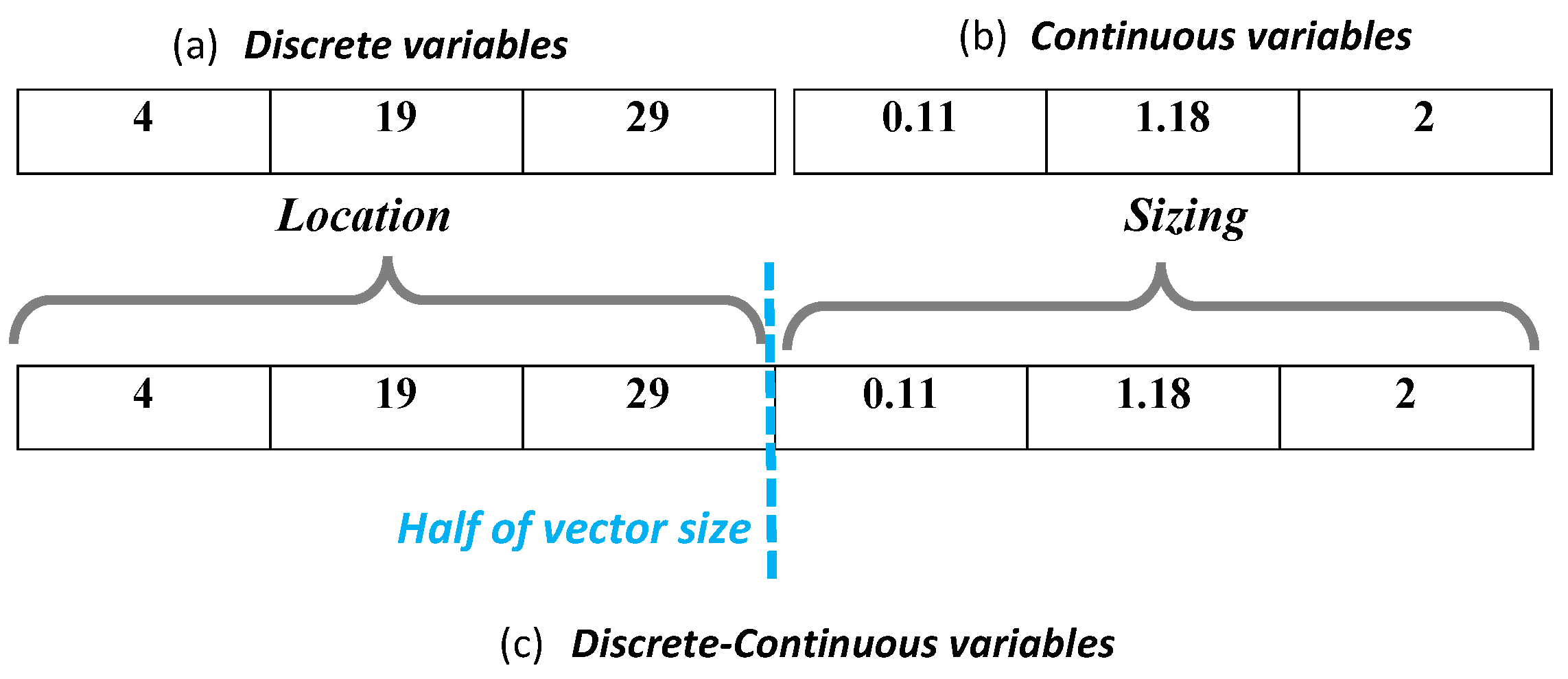
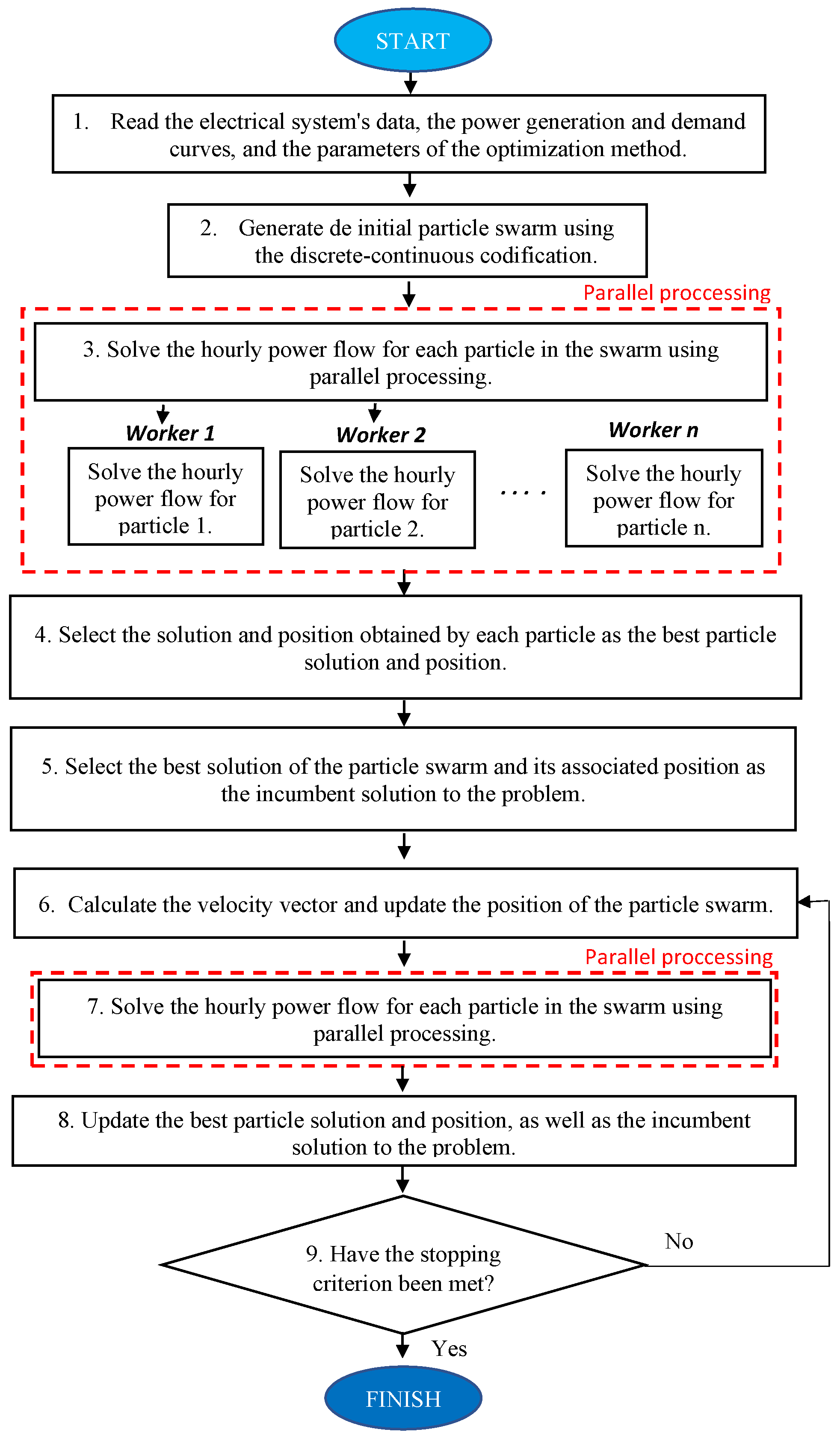
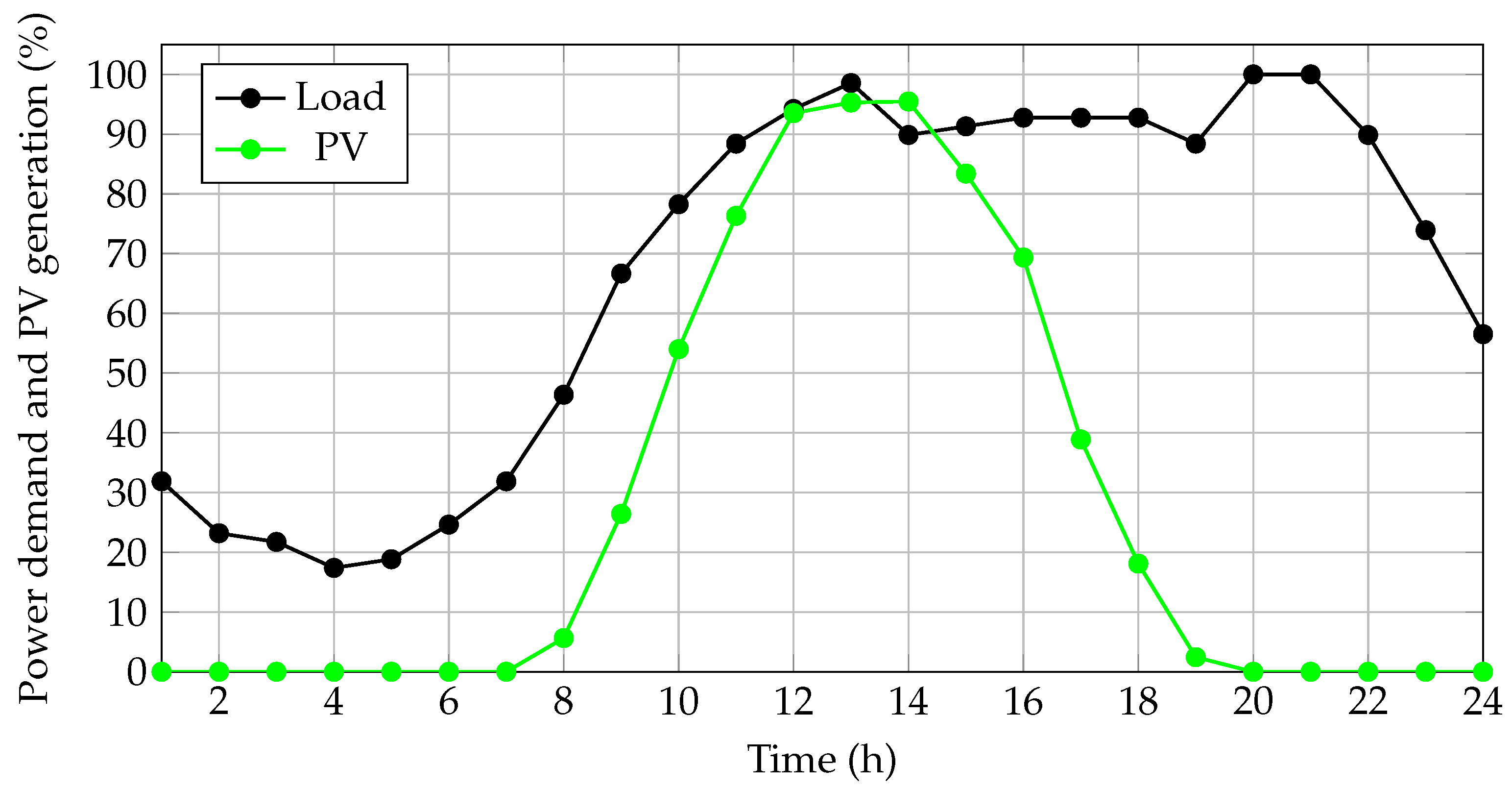
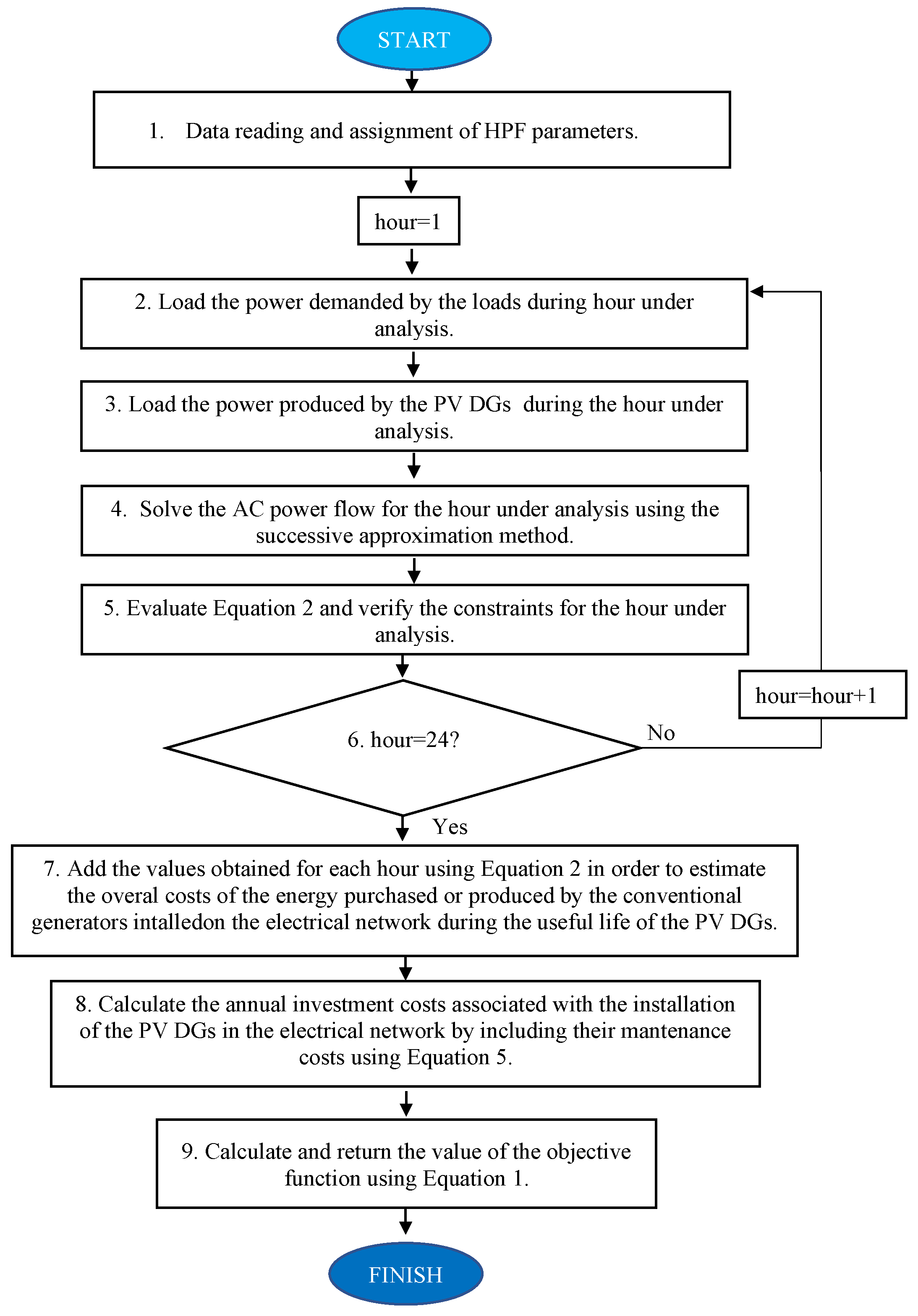
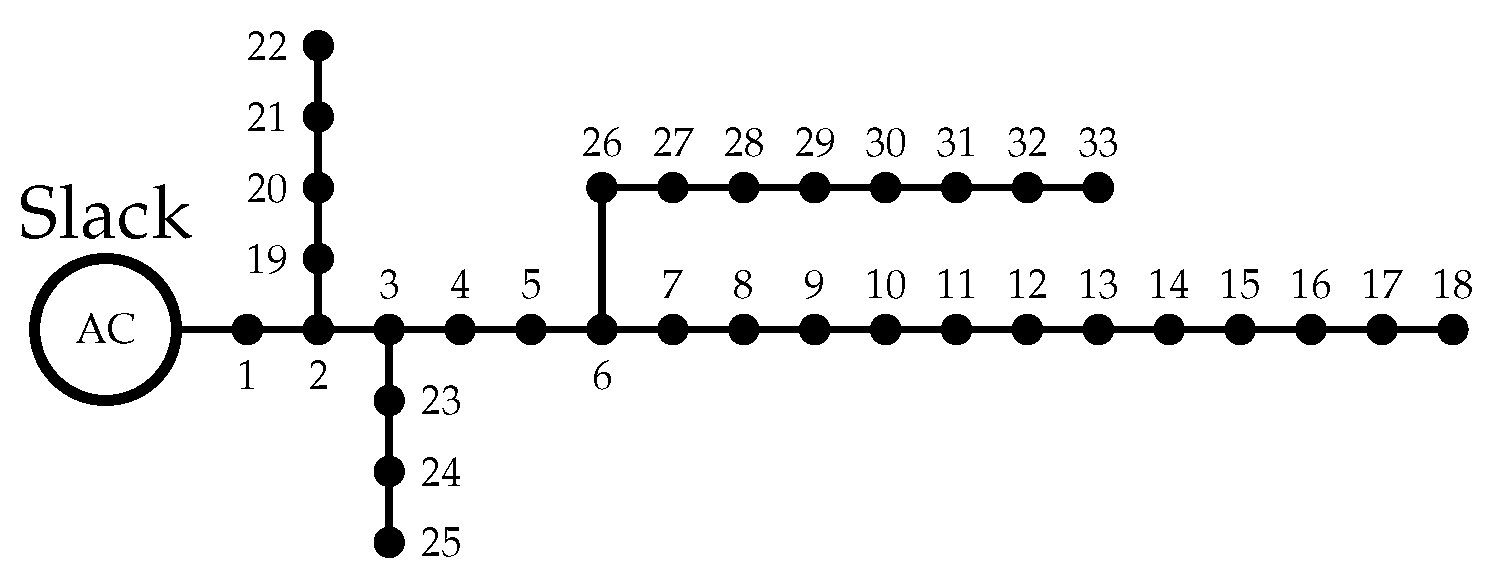
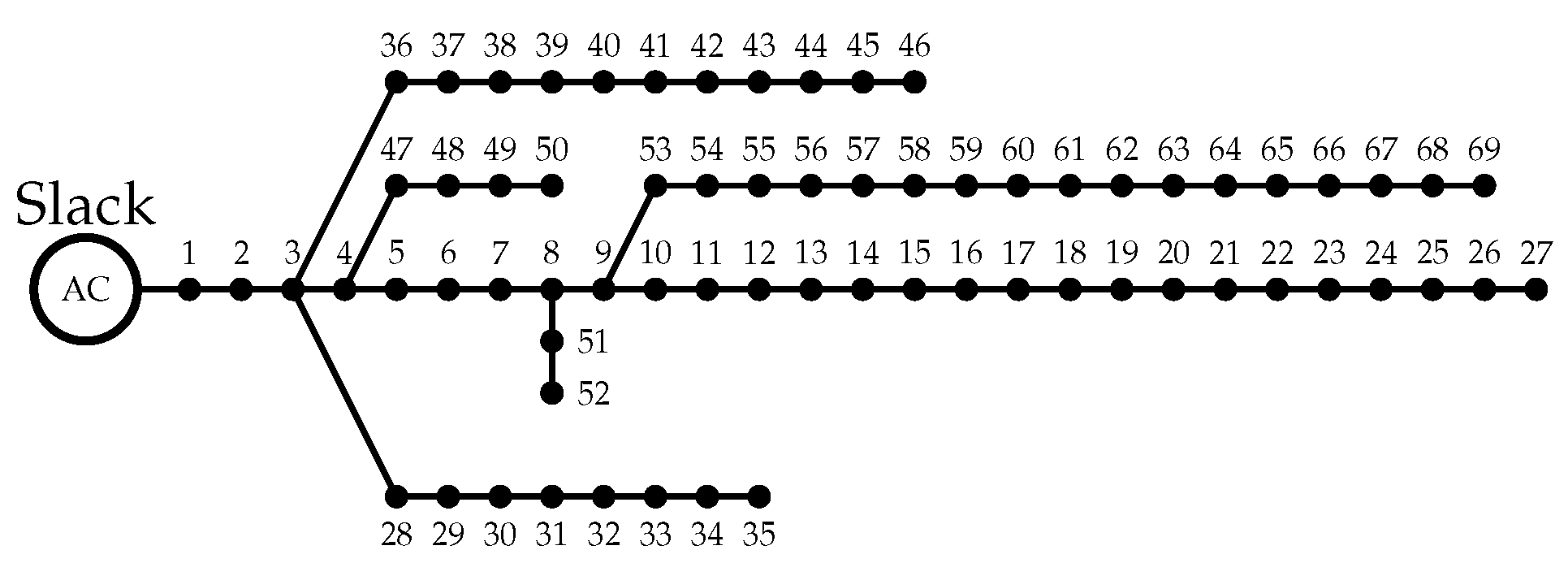
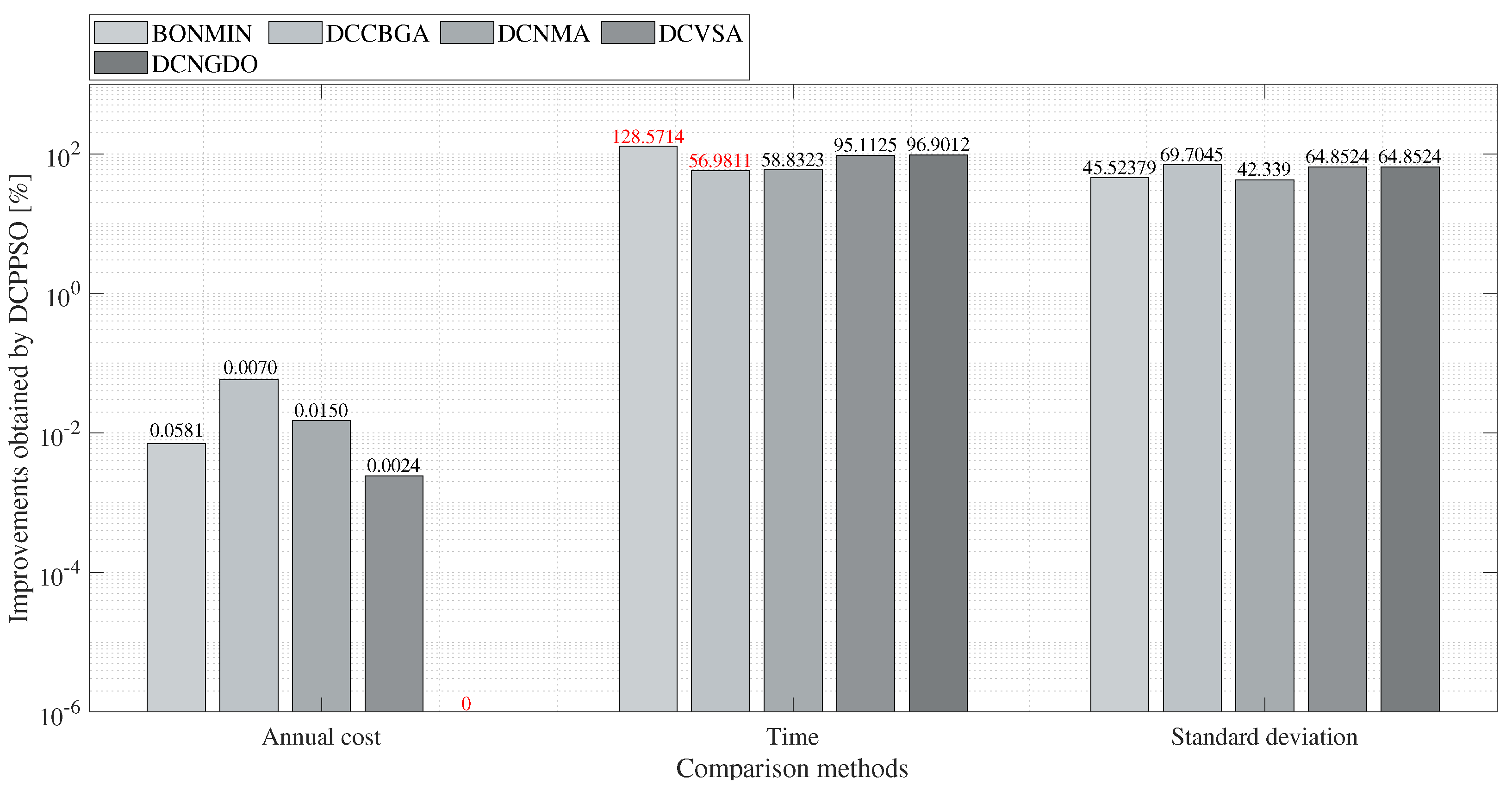

| Parameter | Value | Unit | Parameter | Value | Unit |
|---|---|---|---|---|---|
| 0.1390 | USD/kWh | T | 365 | days | |
| 10 | % | 20 | years | ||
| 1 | h | 2 | % | ||
| 1036.49 | USD/kWp | 0.0019 | USD/kWh | ||
| 3 | - | % | |||
| 0 | kW | 2400 | kW | ||
| USD/V | USD/V | ||||
| USD/W | USD/A |
| Bus i | Bus j | [] | [] | P[kW] | Q[kvar] | Bus i | Bus j | [] | [] | P[kW] | Q[kvar] |
|---|---|---|---|---|---|---|---|---|---|---|---|
| 1 | 2 | 0.0922 | 0.0477 | 100 | 60 | 17 | 18 | 0.7320 | 0.5740 | 90 | 40 |
| 2 | 3 | 0.4930 | 0.2511 | 90 | 40 | 2 | 19 | 0.1640 | 0.1565 | 90 | 40 |
| 3 | 4 | 0.3660 | 0.1864 | 120 | 80 | 19 | 20 | 1.5042 | 1.3554 | 90 | 40 |
| 4 | 5 | 0.3811 | 0.1941 | 60 | 30 | 20 | 21 | 0.4095 | 0.4784 | 90 | 40 |
| 5 | 6 | 0.8190 | 0.7070 | 60 | 20 | 21 | 22 | 0.7089 | 0.9373 | 90 | 40 |
| 6 | 7 | 0.1872 | 0.6188 | 200 | 100 | 3 | 23 | 0.4512 | 0.3083 | 90 | 50 |
| 7 | 8 | 1.7114 | 1.2351 | 200 | 100 | 23 | 24 | 0.8980 | 0.7091 | 420 | 200 |
| 8 | 9 | 1.0300 | 0.7400 | 60 | 20 | 24 | 25 | 0.8900 | 0.7011 | 420 | 200 |
| 9 | 10 | 1.0400 | 0.7400 | 60 | 20 | 6 | 26 | 0.2030 | 0.1034 | 60 | 25 |
| 10 | 11 | 0.1966 | 0.0650 | 45 | 30 | 26 | 27 | 0.2842 | 0.1447 | 60 | 25 |
| 11 | 12 | 0.3744 | 0.1238 | 60 | 35 | 27 | 28 | 1.0590 | 0.9337 | 60 | 20 |
| 12 | 13 | 1.4680 | 1.1550 | 60 | 35 | 28 | 29 | 0.8042 | 0.7006 | 120 | 70 |
| 13 | 14 | 0.5416 | 0.7129 | 120 | 80 | 29 | 30 | 0.5075 | 0.2585 | 200 | 600 |
| 14 | 15 | 0.5910 | 0.5260 | 60 | 10 | 30 | 31 | 0.9744 | 0.9630 | 150 | 70 |
| 15 | 16 | 0.7463 | 0.5450 | 60 | 20 | 31 | 32 | 0.3105 | 0.3619 | 210 | 100 |
| 16 | 17 | 1.2890 | 1.7210 | 60 | 20 | 32 | 33 | 0.3410 | 0.5302 | 60 | 40 |
| Bus i | Bus j | [] | [] | P[kW] | Q[kvar] | Bus i | Bus j | [] | [] | P[kW] | Q[kvar] |
|---|---|---|---|---|---|---|---|---|---|---|---|
| 1 | 2 | 0.0005 | 0.0012 | 0 | 0 | 3 | 36 | 0.0044 | 0.0108 | 26 | 18.55 |
| 2 | 3 | 0.0005 | 0.0012 | 0 | 0 | 36 | 37 | 0.0640 | 0.1565 | 26 | 18.55 |
| 3 | 4 | 0.0015 | 0.0036 | 0 | 0 | 37 | 38 | 0.1053 | 0.1230 | 0 | 0 |
| 4 | 5 | 0.0215 | 0.0294 | 0 | 0 | 38 | 39 | 0.0304 | 0.0355 | 24 | 17 |
| 5 | 6 | 0.3660 | 0.1864 | 2.6 | 2.2 | 39 | 40 | 0.0018 | 0.0021 | 24 | 17 |
| 6 | 7 | 0.3810 | 0.1941 | 40.4 | 30 | 40 | 41 | 0.7283 | 0.8509 | 102 | 1 |
| 7 | 8 | 0.0922 | 0.0470 | 75 | 54 | 41 | 42 | 0.3100 | 0.3623 | 0 | 0 |
| 8 | 9 | 0.0493 | 0.0251 | 30 | 22 | 42 | 43 | 0.0410 | 0.0478 | 6 | 4.3 |
| 9 | 10 | 0.8190 | 0.2707 | 28 | 19 | 43 | 44 | 0.0092 | 0.0116 | 0 | 0 |
| 10 | 11 | 0.1872 | 0.0619 | 145 | 104 | 44 | 45 | 0.1089 | 0.1373 | 39.22 | 26.3 |
| 11 | 12 | 0.7114 | 0.2351 | 145 | 104 | 45 | 46 | 0.0009 | 0.0012 | 39.22 | 26.3 |
| 12 | 13 | 1.0300 | 0.3400 | 8 | 5 | 4 | 47 | 0.0034 | 0.0084 | 0 | 0 |
| 13 | 14 | 1.0440 | 0.3400 | 8 | 5 | 47 | 48 | 0.0851 | 0.2083 | 79 | 56.4 |
| 14 | 15 | 1.0580 | 0.3496 | 0 | 0 | 48 | 49 | 0.2898 | 0.7091 | 384.7 | 274.5 |
| 15 | 16 | 0.1966 | 0.0650 | 45 | 30 | 49 | 50 | 0.0822 | 0.2011 | 384.7 | 274.5 |
| 16 | 17 | 0.3744 | 0.1238 | 60 | 35 | 8 | 51 | 0.0928 | 0.0473 | 40.5 | 28.3 |
| 17 | 18 | 0.0047 | 0.0016 | 60 | 35 | 51 | 52 | 0.3319 | 0.1140 | 3.6 | 2.7 |
| 18 | 19 | 0.3276 | 0.1083 | 0 | 0 | 9 | 53 | 0.1740 | 0.0886 | 4.35 | 3.5 |
| 19 | 20 | 0.2106 | 0.0690 | 1 | 0.6 | 53 | 54 | 0.2030 | 0.1034 | 26.4 | 19 |
| 20 | 21 | 0.3416 | 0.1129 | 114 | 81 | 54 | 55 | 0.2842 | 0.1447 | 24 | 17.2 |
| 21 | 22 | 0.0140 | 0.0046 | 5 | 3.5 | 55 | 56 | 0.2813 | 0.1433 | 0 | 0 |
| 22 | 23 | 0.1591 | 0.0526 | 0 | 0 | 56 | 57 | 1.5900 | 0.5337 | 0 | 0 |
| 23 | 24 | 0.3463 | 0.1145 | 28 | 20 | 57 | 58 | 0.7837 | 0.2630 | 0 | 0 |
| 24 | 25 | 0.7488 | 0.2475 | 0 | 0 | 58 | 59 | 0.3042 | 0.1006 | 100 | 72 |
| 25 | 26 | 0.3089 | 0.1021 | 14 | 10 | 59 | 60 | 0.3861 | 0.1172 | 0 | 0 |
| 26 | 27 | 0.1732 | 0.0572 | 14 | 10 | 60 | 61 | 0.5075 | 0.2585 | 1244 | 888 |
| 3 | 28 | 0.0044 | 0.0108 | 26 | 18.6 | 61 | 62 | 0.0974 | 0.0496 | 32 | 23 |
| 28 | 29 | 0.0640 | 0.1565 | 26 | 18.6 | 62 | 63 | 0.1450 | 0.0738 | 0 | 0 |
| 29 | 30 | 0.3978 | 0.1315 | 0 | 0 | 63 | 64 | 0.7105 | 0.3619 | 227 | 162 |
| 30 | 31 | 0.0702 | 0.0232 | 0 | 0 | 64 | 65 | 1.0410 | 0.5302 | 59 | 42 |
| 31 | 32 | 0.3510 | 0.1160 | 0 | 0 | 65 | 66 | 0.2012 | 0.0611 | 18 | 13 |
| 32 | 33 | 0.8390 | 0.2816 | 10 | 10 | 66 | 67 | 0.0047 | 0.0014 | 18 | 13 |
| 33 | 34 | 1.7080 | 0.5646 | 14 | 14 | 67 | 68 | 0.7394 | 0.2444 | 28 | 20 |
| 34 | 35 | 1.4740 | 0.4873 | 4 | 4 | 68 | 69 | 0.0047 | 0.0016 | 28 | 20 |
| Methodology | Bus/Power [MVAr] | (USD/Year)/Reduction [%] | Time [s] | STD [%] | [p.u.] | [A] |
|---|---|---|---|---|---|---|
| Base case | [0–2.4] | 3,700,455.380 | - | - | [0.9–1.1] | 380 |
| BONMIN | 17/1.3539 18/0.2105 33/2.1451 | 2,701,824.14/29.9867 | 3.64 | 0 | 0.90 | 366 |
| DCCBGA | 11/0.7604 15/0.9689 30/1.9059 | 2,699,932.29/27.0378 | 5.30 | 0.0452 | 0.90 | 366 |
| DCNMA | 8/0.2770 16/1.2688 30/2.0961 | 2,700,227.33/27.0298 | 20.21 | 0.0812 | 0.90 | 365 |
| DCVSA | 11/0.7606 14/1.08517 31/1.8029 | 2,699,761,71/27.0424 | 170.23 | 0.0427 | 0.90 | 366 |
| DCGNDO | 10/1.0083 16/0.9137 31/1.7257 | 2,699,671.75/27.0436 | 268.69 | 0.0700 | 0.90 | 365 |
| DCPPSO | 10/1.0092 16/0.9137 31/1.7245 | 2,699,671.75/27.0436 | 8.32 | 0.0246 | 0.90 | 366 |
| Methodology | Bus/Power [MVAr] | (USD/Year)/Reduction [%] | Time [s] | STD [%] | [p.u.] | [A] |
|---|---|---|---|---|---|---|
| Base case | [0–2.4] | 3,700,455.380 | - | - | [0.9–1.1] | 430 |
| DCCBGA | 24/0.5325 61/1.8954 64/1.3771 | 2,825,783.32/27.1397 | 22.36 | 0.0999 | 0.90 | 394 |
| DCNMA | 12/0.0794 60/1.3805 61/2.3776 | 2,826,368.60/27.1367 | 91.81 | 0.1900 | 0.90 | 393 |
| DCVSA | 16/0.2632 61/2.27197 63/0.11166 | 2,824.923.29/27.1501 | 887.64 | 0.0942 | 0.90 | 394 |
| DCGNDO | 21/0.4812 61/2.4 64/0.9169 | 2,824923.38/27.1589 | 1237.23 | 0.2558 | 0.90 | 393 |
| DCPPSO | 21/0.489 61/2.4 64/0.9169 | 2,824,923.29/27.1589 | 55.15 | 0.0267 | 0.90 | 393 |
Publisher’s Note: MDPI stays neutral with regard to jurisdictional claims in published maps and institutional affiliations. |
© 2022 by the authors. Licensee MDPI, Basel, Switzerland. This article is an open access article distributed under the terms and conditions of the Creative Commons Attribution (CC BY) license (https://creativecommons.org/licenses/by/4.0/).
Share and Cite
Grisales-Noreña, L.F.; Montoya, O.D.; Marín-García, E.-J.; Ramos-Paja, C.A.; Perea-Moreno, A.-J. Integration of PV Distributed Generators into Electrical Networks for Investment and Energy Purchase Costs Reduction by Using a Discrete–Continuous Parallel PSO. Energies 2022, 15, 7465. https://doi.org/10.3390/en15207465
Grisales-Noreña LF, Montoya OD, Marín-García E-J, Ramos-Paja CA, Perea-Moreno A-J. Integration of PV Distributed Generators into Electrical Networks for Investment and Energy Purchase Costs Reduction by Using a Discrete–Continuous Parallel PSO. Energies. 2022; 15(20):7465. https://doi.org/10.3390/en15207465
Chicago/Turabian StyleGrisales-Noreña, Luis Fernando, Oscar Danilo Montoya, Edward-J. Marín-García, Carlos Andres Ramos-Paja, and Alberto-Jesus Perea-Moreno. 2022. "Integration of PV Distributed Generators into Electrical Networks for Investment and Energy Purchase Costs Reduction by Using a Discrete–Continuous Parallel PSO" Energies 15, no. 20: 7465. https://doi.org/10.3390/en15207465
APA StyleGrisales-Noreña, L. F., Montoya, O. D., Marín-García, E.-J., Ramos-Paja, C. A., & Perea-Moreno, A.-J. (2022). Integration of PV Distributed Generators into Electrical Networks for Investment and Energy Purchase Costs Reduction by Using a Discrete–Continuous Parallel PSO. Energies, 15(20), 7465. https://doi.org/10.3390/en15207465








